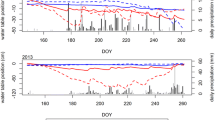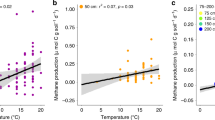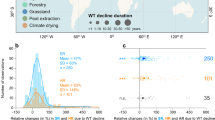Abstract
Mountain peatlands are understudied globally, especially in tropical regions such as the Andes. Their high abundance across the landscape and thick carbon (C)-rich soils establish them as regionally important C reservoirs. However, they are at high risk of degradation due to unsustainable land use and climate change. Mitigation of these threats requires detailed inventories of C stocks present and improved understanding of the major drivers of long-term C accumulation in these ecosystems. We cored 24 peatlands located between 3000 and 4800 m elevation across Colombia, Ecuador, Peru, and Bolivia, calculated C storage and long-term and recent apparent rate of C accumulation (LARCA and RARCA, respectively), and tested their relationships to environmental variables (elevation, temperature, precipitation, and solar radiation). The peatlands had a mean thickness of 4.7 m (range, 0.7‒11.25 m). The mean age of peatland was 7918 yrs B.P., with a range from 490 to 20,000 yrs B.P. The mean C stock was 1743 Mg ha-1 and did not significantly vary by climatic region or basal age but did increase with elevation. LARCA was best predicted by age and elevation, while RARCA was negatively related to mean annual temperature. These findings indicate that peatlands in the tropical Andes store thick deposits of soil C that are likely influenced by temperature, making them vulnerable to changes in climate. To inform climate policy, there is a need for science that will determine the potential for adaptation and mitigation treatments to increase the resilience of these C-rich ecosystems to climate change.





Similar content being viewed by others
Data availability
Soil physical properties of bulk density, % C, and % organic matter for all 25 peat cores can be accessed at the CIFOR Database of tropical wetlands carbon survey: Soil (https://data.cifor.org/dataverse/swamp-soil/).
References
Balslev H, Luteyn J (1992) Paramo, an Andean ecosystem under human influence. Academic Press
Benavides JC (2014) The effect of drainage on organic matter accumulation and plant communities of high-altitude peatlands in the Colombian tropical Andes. Mires and Peat 15:1–15
Billings WD, Mooney HA (1968) The ecology of arctic and alpine plants. Biol Rev Camb Philos Soc 43:481–529
Bourgeau-Chavez LL, Grelik SL, Battaglia MJ et al (2021) Advances in Amazonian peatland discrimination with multi-temporal PALSAR refines estimates of peatland distribution, C Stocks and Deforestation. Front Earth Sci Chin 9:1019
Chambers FM, Beilman DW, Yu Z (2011) Methods for determining peat humification and for quantifying peat bulk density, organic matter and carbon content for palaeostudies of climate and peatland carbon dynamics. Mires Peat 7
Chimborazo O, Minder JR, Vuille M (2022) Observations and simulated mechanisms of elevation-dependent warming over the Tropical Andes. Journal of Climate 35:1021–1044
Chimner RA (2000) Carbon dynamics of southern Rocky Mountain fens. Colorado State University, Fort Collins CO, Ph.D
Chimner RA (2004) Soil respiration rates of tropical peatlands in Micronesia and Hawaii. Wetlands 24:51–56
Chimner RA, Cooper DJ, Parton WJ (2002) Modeling carbon accumulation in Rocky Mountain fens. Wetlands 22:100–110
Chimner RA, Lemly JM, Cooper DJ (2010) Mountain fen distribution, types and restoration priorities, San Juan Mountains, Colorado, USA. Wetlands 30:763–771
Chimner RA, Bourgeau-Chavez L, Grelik S et al (2019) Mapping mountain peatlands and wet meadows using multi-date, multi-sensor remote sensing in the Cordillera Blanca, Peru. Wetlands 39:1057–1067
Chimner RA, Karberg JM (2008) Long-term carbon accumulation in two tropical mountain peatlands, Andes Mountains, Ecuador. Mires Peat 3:1–10
Chimner RA, Boone R, Bowser G, et al (2020) Andes, Bofedales, and the Communities of Huascarán National Park, Peru. Wetland Sci Pract 37: 246-254
Cleef AM (1979) The phytogeographical position of the neotropical vascular páramo flora with special reference to the Colombian Cordillera Oriental. Trop Botany 175–184
Clymo RS, Kramer JR, Hammerton D et al (1984) Sphagnum-dominated peat bog: a naturally acid ecosystem. Philos Trans R Soc Lond B Biol Sci 305:487–499
Cong J, Gao C, Xing W et al (2022) Historical chemical stability of carbon pool in permafrost peatlands in northern Great Khingan Mountains (China) during the last millennium, and its paleoenvironmental implications. Catena 209:105853
Cooper DJ, Wolf EC, Colson C et al (2010) Alpine peatlands of the Andes, Cajamarca, Peru. Arct Antarct Alp Res 42:19–33
Cooper DJ, Kaczynski K, Slayback D, Yager K (2015) Growth and organic carbon production in peatlands dominated by Distichia muscoides, Bolivia, South America. Arctic Antarct Alpine Res 47:505–510
Cooper DJ, Merritt DM (2012) Assessing the water needs of riparian and wetland vegetation in the western United States. Gen. Tech. Rep. RMRS-GTR-282. Fort Collins, CO: US Department of Agriculture, Forest Service, Rocky Mountain Research Station
Cooper DJ, Chimner RA, Merritt DM (2012) Mountain wetlands of North America. In: Batzer D, Baldwin A (eds) Wetland habitats of North America: ecology and conservation concerns. University of California Press, Berkeley, CA
Cooper DJ, Sueltenfuss J, Oyague E, et al (2019) Drivers of peatland water table dynamics in the central Andes, Bolivia and Peru. Hydrol Process https://doi.org/10.1002/hyp.13446
Dargie GC, Lewis SL, Lawson IT et al (2017) Age, extent and carbon storage of the central Congo Basin peatland complex. Nature 542:86–90
Davis JC, Proctor ID, Southon JR, et al (1990) LLNL/UC AMS facility and research program. In: Yiou F, Raisbeck GM (eds) Proceedings of the 5th International Conference on Accelerator Mass Spectrometry. Nucl Instruments Methods 269–272
Draper FC, Roucoux KH, Lawson IT et al (2014) The distribution and amount of carbon in the largest peatland complex in Amazonia. Environ Res Lett 9:124017
Dylan M, Young Andy J, Baird Angela V, Gallego-Sala JL (2021) A cautionary tale about using the apparent carbon accumulation rate (aCAR) obtained from peat cores Abs Sci Rep 11(1). https://doi.org/10.1038/s41598-021-88766-8
Earle LR, Warner BG, Aravena R (2003) Rapid development of an unusual peat-accumulating ecosystem in the Chilean Altiplano. Quat Res 59:2–11
Fairman TA, Nitschke CR, Bennett LT (2022) Carbon stocks and stability are diminished by short-interval wildfires in fire-tolerant eucalypt forests. For Ecol Manage 505:119919
Fick SE, Hijmans RJ (2017) WorldClim 2: new 1-km spatial resolution climate surfaces for global land areas. Int J Climatol 37:4302–4315
Flantua SGA, Hooghiemstra H, Vuille M et al (2016) Climate variability and human impact in South America during the last 2000 years: synthesis and perspectives from pollen records. Clim Past 12:483–523
Frederick L, Brunelle A, Morrison M et al (2018) Reconstruction of the mid-Holocene paleoclimate of the Ecuadorian Andean páramo at Tres Lagunas, Ecuador. Holocene 28:1131–1140
Gallego-Sala AV, Charman DJ, Brewer S et al (2018) Latitudinal limits to the predicted increase of the peatland carbon sink with warming. Nat Clim Chang 8:907–913
Grundling PL, Grootjans AP (2018) Peatlands of Africa. In: Finlayson C, Milton G, Prentice R, Davidson N (eds) The Wetland Book. Springer Science and Business Media, LLC
Gumbricht T, Roman-Cuesta RM, Verchot L et al (2017) An expert system model for mapping tropical wetlands and peatlands reveals South America as the largest contributor. Glob Chang Biol 23:3581–3599
Hodgkins SB, Richardson CJ, Dommain R, et al (2018) Tropical peatland carbon storage linked to global latitudinal trends in peat recalcitrance. Nat Commun 9 https://doi.org/10.1038/s41467-018-06050-2
Hope GS (2015) Peat in the Mountains of New Guinea. Mires Peat 15:1–21
Hribljan JA, Suárez E, Heckman KA et al (2016) Peatland carbon stocks and accumulation rates in the Ecuadorian páramo. Wetlands Ecol Manage 24:113–127
Hribljan JA, Suarez E, Bourgeau-Chavez L et al (2017) Multidate, multisensor remote sensing reveals high density of carbon-rich mountain peatlands in the páramo of Ecuador. Glob Chang Biol 23:5412–5425
Hribljan JA, Cooper DJ, Sueltenfuss J et al (2015) Carbon storage and long-term rate of accumulation in high-altitude Andean peatlands of Bolivia. Mires Peat 15:1–14
Jantz N, Behling H (2011) A Holocene environmental record reflecting vegetation, climate, and fire variability at the Páramo of Quimsacocha, southwestern Ecuadorian Andes. Veg History Archaeobotany 21:3
Joosten H, Clarke D (eds) (2002) Wise use of mires and peatlands. International Mire Conservation Group & International Peat Society, Saarijärvi, Finland
Josse C, Cuesta F, Navarro G, et al (2009) Ecosistemas de los Andes del Norte y Centro. Bolivia, Colombia, Ecuador, Perú y Venezuela. Secretaría General de la Comunidad Andina, Programa Regional ECOBONA-Intercooperation, CONDESAN-Proyecto Páramo Andino, Programa BioAndes, EcoCiencia, NatureServe, IAvH, LTA-UNALM, ICAE-ULA, CDC-UNALM, RUMBOL SRL., Lima
Khan A, Said A, Ullah I (2020) Landsat based distribution mapping of high-altitude peatlands in Hindu Kush Himalayas — a case study of Broghil Valley, Pakistan. J Mountain Sci 17:42–49
Lähteenoja O, Reátegui YR, Räsänen M et al (2012) The large Amazonian peatland carbon sink in the subsiding Pastaza-Marañón foreland basin, Peru. Glob Change Biol 18:164–178
Loisel J, Yu Z, Beilman DW et al (2014) A database and synthesis of northern peatland soil properties and Holocene carbon and nitrogen accumulation. Holocene 24:1028–1042
Loisel J, Gallego-Sala AV, Amesbury MJ et al (2020) Expert assessment of future vulnerability of the global peatland carbon sink. Nat Clim Chang 11:70–77
Longman J, Veres D, Haliuc A et al (2021) Carbon accumulation rates of Holocene peatlands in central-eastern Europe document the driving role of human impact over the past 4000 years. Climate of the Past 17:2633–2652
Luteyn JL (1999) Páramos, a checklist of plant diversity, geographical distribution, and botanical literature, vol 278. New York Botanical Garden Press, New York
Matus F, Rumpel C, Neculman R et al (2014) Soil carbon storage and stabilisation in andic soils: a review. Catena 120:102–110
McCormac FG, Hogg AG, Blackwell PG et al (2004) Shcal04 Southern Hemisphere Calibration, 0–11.0 Cal Kyr BP. Radiocarbon 46:1087–1092
Millar DJ, Cooper DJ, Dwire KA et al (2016) Mountain peatlands range from CO2 sinks at high elevations to sources at low elevations: implications for a changing climate. Ecosystems 20:416–432
MINAM Mapa Nacional de Ecosistemas del Perú (n.d.) https://www.gob.pe/institucion/minam/informes-publicaciones/277146-mapa-nacional-de-ecosistemas-del-peru. Accessed 4 Jan 2022
Nasi R, Putz FE, Pacheco P et al (2011) Sustainable Forest management and carbon in tropical Latin America: the case for REDD+. Forests 2:200–217
Ott CA, Chimner RA (2016) Long-term peat accumulation in temperate forested peatlands (Thuja occidentalis swamps) in the Great Lakes region of North America. Mires Peat 18:1–9
Oyague E, Cooper DJ (2020) Peatlands of the Central Andes Puna, South America. Wetland Sci Pract 37:255–260
Page SE, Rieley JO, Banks CJ (2011) Global and regional importance of the tropical peatland carbon pool. Glob Chang Biol 17:798–818
Planas-Clarke AM, Chimner RA, Hribljan JA et al (2020) The effect of water table levels and short-term ditch restoration on mountain peatland carbon cycling in the Cordillera Blanca, Peru. Wetlands Ecol Manag 28:51–69
R Core Team (2021) R: a language and environment for statistical computing. R Foundation for Statistical Computing, Vienna
Ratcliffe JL, Lowe DJ, Schipper LA et al (2020) Rapid carbon accumulation in a peatland following Late Holocene tephra deposition. New Zealand. Quat Sci Rev 246:106505
Reimer PJ (2004) Intcal04: terrestrial radiocarbon age calibration, 0–26 cal kyr BP. Radiocarbon 46:1029–1058
Romano GM (2017) A high resolution shapefile of the Andean biogeographical region. Data Brief 13:230–232
Salvador F, Monerris J, Rochefort L (2015) Peatlands of the Peruvian Puna ecoregion: types, characteristics and disturbance. Mires Peat 15:1–17
Sánchez ME, Chimner RA, Hribljan JA, et al (2017) Carbon dioxide and methane fluxes in grazed and undisturbed mountain peatlands in the Ecuadorian Andes. Mires Peat https://doi.org/10.19189/MaP.2017.OMB.277
Soil Survey Staff (2014) Keys to soil taxonomy. USDA-Natural Resources Conservation Service, Washington, D.C.
Stuiver M, Polach HA (1977) Discussion reporting of 14C data. Radiocarbon 19:355–363
Stuiver M, Reimer PJ (1993) Extended 14C data base and revised CALIB 3.0 14C age calibration program. Radiocarbon 35:215–230
Suarez E,, Chimbolema S, , Jaramillo RM, Zurita-Arthos L, Arellano P, Chimner RA, Stanovick JS, Lilleskov EA (2022) Challenges and opportunities for restoration of high-elevation Andean peatlands in Ecuador. Mitig. Adap. Strat. Glob. Clim. Change, this issue (in press)
Tolonen K, Turunen J (1996) Accumulation rates of carbon in mires in Finland and implications for climate change. Holocene 6:171–178
Tomaselli M, Gualmini M, Petraglia A et al (2018) Three mires in the south-eastern Alps (northern Italy). J Maps 14:303–311
Valencia JB, Mesa J, León JG, et al (2020) Climate vulnerability assessment of the Espeletia complex on Páramo Sky Islands in the Northern Andes. Front Ecol Evol 8 https://doi.org/10.3389/fevo.2020.565708
Vogel JS, Southon JR, Nelson DE (1987) Catalyst and binder effects in the use of filamentous graphite for AMS. Nucl Instrum Methods Phys Res B 29:50–56
Wickham H (2016) Getting Started with ggplot2. In: ggplot2. Use R!. Springer, Cham
Wolf EC, Cooper DJ (2015) Fens of the Sierra Nevada, California, USA: patterns of distribution and vegetation. Mires Peat 15:1–22
Xing W, Bao K, Gallego-Sala AV et al (2015) Climate controls on carbon accumulation in peatlands of Northeast China. Quat Sci Rev 115:78–88
Yang S, Jansen B, Absalah S et al (2020) Lithology- and climate-controlled soil aggregate-size distribution and organic carbon stability in the Peruvian Andes. SOIL 6:1–15
Yu Z, Beilman DW, Frolking S et al (2011) Peatlands and their role in the global carbon cycle. Eos 92:97–98
Zhou T, Geng Y, Ji C et al (2021) Prediction of soil organic carbon and the C: N ratio on a national scale using machine learning and satellite data: a comparison between Sentinel-2, Sentinel-3 and Landsat-8 images. Sci Total Environ 755:142661
Acknowledgements
We thank the Ministry of the Environment and Ecological Transition (MAEE) of Ecuador for issuing research permits No. 001-2015-RIC-FLO-DPAP-MA, No. 08-15-IC-FAU-DPAP-MA, and MAAE-ARSFC-2020-1057 for our work at the Cayambe-Coca National Park and Antisana Ecological Reserve and the Laboratory of Aquatic Ecology (LEA-USFQ) for logistical support. We thank the staff at Huascarán National Park for all their support (Permit No PNH-008-2012, RJ No. 11-2015-SERNANP PHN and RJ No. 13-2017-SERNANP-JEF from Servicio Nacional de Áreas Naturales Protegidas por el Estado). We also thank Ellen Beller, Alexander N. Brown, Jonathan Bontrager , Erin Cary (USFS International Programs), Segundo Chimbolema, Michelle Cisz, Ellie Crane, Francisco Cuesta, Aric Devens, Jennifer Eikenberry, Christa M. Luokkala, Austin Meyer, Priscilla Muriel, Manuel Peralvo, Lynette Potvin, José Scherekinger, Karena Schmidt, Beth Spedowski, María Elisa Sánchez, Andrea Vega, Tim Veverica, and field crews for helping us collect data and reviewers for improving the quality of the manuscript. The Institute of Hydrology, Meteorology and Environmental Studies (IDEAM) provided valuable coordination for site visits in Colombia. We thank Don Aurelio for graciously permitting access to the pastures of Manasaya in Bolivia. Radiocarbon analysis was supported by the Radiocarbon Collaborative, which is jointly sponsored by the USDA Forest Service, the W.M. Keck Carbon Cycle Accelerator Mass Spectrometer Facility at University of California, Irvine, and Michigan Technological University (MTU). The study area map was prepared by José Daza.
Funding
This work was supported by the Sustainable Wetlands Adaptation and Mitigation Program (SWAMP) and the USDA Forest Service Northern Research Station. E. Suarez received support from PREPA grants from Universidad San Francisco de Quito. David Cooper, Jeremy Sueltenfuss, and Evan Wolf provided support and research assistance in Boliva that was funded in part by NASA’s Land Cover and Use Change program.
Author information
Authors and Affiliations
Corresponding author
Ethics declarations
Competing interests
The authors declare no competing interests.
Additional information
Publisher's Note
Springer Nature remains neutral with regard to jurisdictional claims in published maps and institutional affiliations.
Supplementary Information
Below is the link to the electronic supplementary material.
Rights and permissions
Springer Nature or its licensor (e.g. a society or other partner) holds exclusive rights to this article under a publishing agreement with the author(s) or other rightsholder(s); author self-archiving of the accepted manuscript version of this article is solely governed by the terms of such publishing agreement and applicable law.
About this article
Cite this article
Hribljan, J.A., Hough, M., Lilleskov, E.A. et al. Elevation and temperature are strong predictors of long-term carbon accumulation across tropical Andean mountain peatlands. Mitig Adapt Strateg Glob Change 29, 1 (2024). https://doi.org/10.1007/s11027-023-10089-y
Received:
Accepted:
Published:
DOI: https://doi.org/10.1007/s11027-023-10089-y




